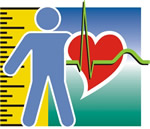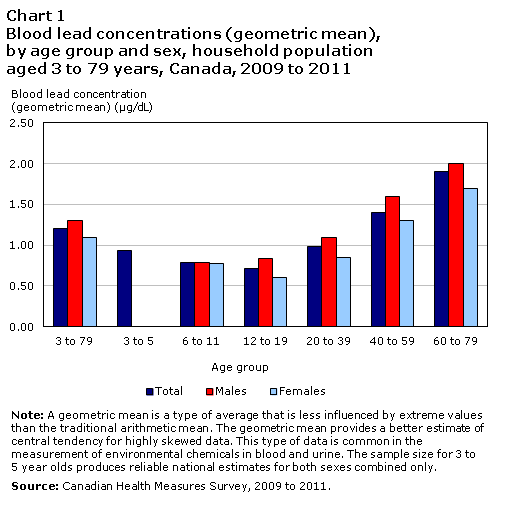Publications
Blood lead concentrations in Canadians, 2009 to 2011
Blood lead concentrations in Canadians, 2009 to 2011
Archived Content
Information identified as archived is provided for reference, research or recordkeeping purposes. It is not subject to the Government of Canada Web Standards and has not been altered or updated since it was archived. Please "contact us" to request a format other than those available.
 Lead is a naturally occurring metal released into the environment by natural processes including erosion and volcanic activity.Note 1 However, through industrial activities, such as historical use of leaded gasoline, lead has been released into the environment. Adults are mainly exposed to lead through the food they eat and the water they drink.Note 1, Note 2 Infants and young children are also exposed through house dust, soil and through putting other things containing lead in their mouths.Note 2
Lead is a naturally occurring metal released into the environment by natural processes including erosion and volcanic activity.Note 1 However, through industrial activities, such as historical use of leaded gasoline, lead has been released into the environment. Adults are mainly exposed to lead through the food they eat and the water they drink.Note 1, Note 2 Infants and young children are also exposed through house dust, soil and through putting other things containing lead in their mouths.Note 2 Lead can be harmful to people of all ages. In infants and children, exposure to low levels of lead may have subtle effects on their intellectual development and behaviour.Note 3 They are particularly vulnerable to the harmful effects of lead because their growing bodies absorb lead more easily and get rid of it less efficiently than adults.Note 3 In adults, the strongest scientific evidence to date suggests low levels of lead exposure may cause a small increase in blood pressure.Note 3 The current blood lead intervention level is 10 µg/dL.Note 2 This is the level at which action is recommended to reduce exposure. However, there is evidence to indicate that negative health effects are occurring at lower levels of exposure than previously thought.Note 2, Note 3
Most Canadians have blood lead levels much lower than the current blood lead intervention level
In 2009 to 2011, 100% of Canadians aged 3 to 79 had lead in their blood; however, almost all of the Canadian population had blood lead levels lower than the current blood lead intervention level of 10 µg/dL. The average lead level for 6 to 79 year olds was 1.2 µg/dL. This is about 11% lower than the average level reported in 2007 to 2009 and four times lower than the average level measured in the 1978 to 1979 Canada Health Survey.
Lead concentrations higher in males and older adults
Children aged 3 to 5 years had blood lead levels of 0.93 µg/dL which is higher than the levels found in children and youth aged 6 to 19 (Chart 1). Adults aged 60 to 79 had the highest lead levels, reaching 1.9 µg/dL. Males tend to have higher lead levels than females in all age groups, except in children aged 6 to 11 years where there is no difference in lead concentrations. The survey was not designed to provide estimates by sex for children aged 3 to 5.
Lead levels affected by several other factors
As was the case in 2007 to 2009,Note 4 blood lead levels were higher among:
- People with lower household incomes compared to those with the highest household incomes;
- People born outside Canada compared to those born in Canada;
- People who live in homes that are more than 50 years old compared to those that live in homes that are less than 20 years old; and
- People who are current smokers or drink alcohol once or more a week compared to those that never smoke or drink alcohol less than once per week.
Data source
Data are from the 2009 to 2011 Canadian Health Measures Survey (CHMS). The CHMS collected data from a nationally representative sample of Canadians aged 3 to 79 years from 18 collection sites across Canada. Basic demographic and health information was collected during a household interview, followed by a series of direct physical measurements taken at a mobile examination centre. Blood and urine samples were collected from consenting respondents aged 3 to 79. The CHMS measured lead in blood samples.
References
- Agency for Toxic Substances and Disease Registry (ATSDR). Toxicological profile for lead. U.S. Department of Health and Human Services, Atlanta, GA. 2007. Accessed March 27, 2012.
- Health Canada. Final human health state of the science report on lead. Ottawa: Minister of Health; 2013. Accessed March 8, 2013
- Health Canada. 2013. It’s Your Health: Lead and Human Health. Accessed February 27, 2013.
- Bushnik T, Haines D, Levallois P, Levesque J, Oostdam JV, Viau C. Lead and bisphenol A concentrations in the Canadian population. Health Reports (Statistics Canada, Catalogue 82-003) 2010; 21(3). Accessed March 8, 2013.
For more information on the Canadian Health Measures Survey, please contact Statistics Canada’s Statistical Information Service (toll-free 1-800-263-1136; 613-951-8116; infostats@statcan.gc.ca).
- Date modified:

